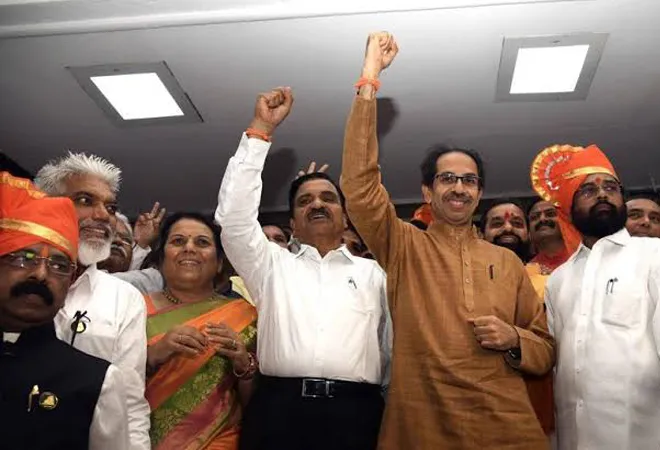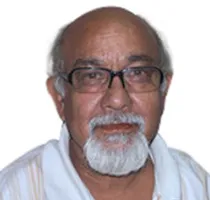
Over a month-long political uncertainty in Maharashtra culminating into a four-day long gripping drama ended with the Supreme Court directive to 80 hour old BJP-led government to take a floor test. This directive, finally resulted in the installation of a Shiv Sena led coalition government on November 28 whose partners are ideologically divergent yet have allegedly come together to serve the interest of the state and its people.
Political crisis in Maharashtra began with the announcement of assembly election results on 24 October in which the BJP-Shiv Sena combine had won a clear majority by winning 160 seats out of the total of 288 assembly seats. But, the two pre-poll alliance partners failed to stake claim to form a government amidst mutual acrimony and multiple round of blame game. . The Shiv Sena asserted that its senior partner has promised to share the post of chief-ministership for two and a half years, but, BJP chose to deny it vehemently.
While the two waited for each other to blink first so that a government could be formed, each party simultaneously began to explore other avenues to have a majority for staking a claim to form a government. The Shiv Sena got in touch with veteran Maratha leader Sharad Pawar and a section of Congress leadership in the state. The NCP had won 54 seats in the elections to form a joint government and the Congress had won 44 seats – which was quite a handsome number to support the Shiv Sena which had 56 seats of its own. This would have helped Shivsena to gain majority in the state assembly.
Meanwhile, the Governor was trying to exhaust all options for formation of a popular government and invited the BJP, Shiv Sena and NCP one after another to form a government, which was denied by r the BJP. After that, the Shiv Sena and NCP asked for some more time to stake a claim. Koshyari declined to grant more time and recommended President rule on the state on November 11 to the Union Home Ministry and Maharashtra was brought under the central rule the very next day though efforts to form a government continued.
The Shiv Sena, NCP and the Congress were slowly but surely moving towards government formation while taking time to arrive at a common minimum programme (CMP) and other issues related with the formation of an alliance.
Suddenly, the BJP sprung a surprise catching its political rivals unaware in the wee hours of Saturday night (23 November), when the Governor recommended lifting of the President rule to the Union Home Ministry. This was done after former state chief minister Devendra Fadnavis staked his claim to form a government with the support of the NCP whose legislature party leader Ajit Pawar allegedly on his violation had handed over the letter of support to BJP without taking the rest of his party into confidence.
Prime Minister Narendra Modi lost no time and ensured his government’s recommendation to lift the President’s rule without even convening his cabinet, that has been the usual norm, to President Ramnath Kovind who signed the order at 5.47 am. This paved the way for Governor Bhagat Singh Koshyari to administer oath of office to Fadnavis and Ajit Pawar for the post of Chief Minister and Deputy Chief Minister respectively. At the same time, the Governor gave a week time to take the floor test to prove the majority.
The three numerically bigger parties – the Shiv Sena, the NCP and the Congress – that had mutually agreed to stake claim for forming the government on Saturday itself – moved a joint petition to the Supreme Court challenging the Governor’s decision to install a government which did not have a majority. In its order, the apex court, after two days of hearing arguments from both sides. made a floor test mandatory by its order. Fadnavis tendered his resignation with the Governor making the way clear for the next government formation.
A Shiv Sena-NCP-Congress coalition government in Maharashtra led by Chief Minister Uddhav Thackeray was sworn in on November 28 evening at the Shivaji Park. Though erstwhile ideological opponents - the Congress and the Shiv Sena - have come together to oppose the dominance of the RSS-BJP but the real test of the exercise starts now as the new government in the finance capital of the country begins to grapple with issues of governance and problems of a federal polity.
NCP supremo Sharad Pawar, who has painstakingly crafted the coalition with a powerful argument that the three must come together to take on the BJP’s centralised style of functioning, is faced with a humongous task to keep the unity of purpose so Maharashtra Vikas Aghadi could be looked at as a viable alternative for the rest of the country.
Undoubtedly, there are several contradictions along with that have the potential of bringing down the coalition but in such situations test of real leadership comes. Positive for the three-party combine is that all the three are equal partners in the government and there is no remote control as Shiv Sena chief himself is leading from the front.
In a way, it is a contest between the regional assertion or should be call regional pride and the rhetoric of nationalism that made the RSS-BJP combine making big electoral strides in national politics.
Success of the political experiment in Maharashtra would result in similar exercises in different states and a failure would consolidate the BJP’s hold on people’s psyche further sustaining it in power for a longer time.
The views expressed above belong to the author(s). ORF research and analyses now available on Telegram! Click here to access our curated content — blogs, longforms and interviews.




 PREV
PREV


